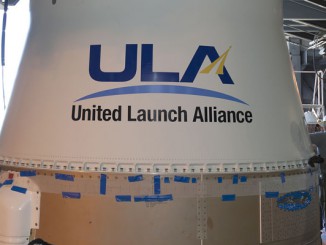EDITOR’S NOTE: Updated after scrub May 17 to reflect new launch date.
This is the launch timeline to be followed by the Atlas 5 rocket’s ascent into orbit from Cape Canaveral with the SBIRS GEO 5 satellite for U.S. military infrared reconnaissance. Launch is scheduled for Tuesday at 1:31 p.m. EDT (1731 GMT).
The Atlas 5 has a 40-minute window for takeoff Tuesday, and the 194-foot-tall rocket will arc to the east from Florida’s Space Coast on its first flight of the year. It will be the 87th Atlas 5 launch overall since United Launch Alliance’s workhorse rocket debuted in August 2002.
The timeline below ends with the conclusion of the primary mission, the deployment of the SBIRS GEO 5 satellite into geostationary transfer orbit. The Centaur’s RL10 engine will ignite a third time at T+plus 1 hour, 19 minutes, 27 seconds, for a planned 13-second de-orbit burn.
Follow live coverage of the countdown and launch in our Mission Status Center.
T+00:01.1: Liftoff

With the RD-180 main engine running and two solid rocket boosters firing, the Atlas 5 vehicle lifts off with 1.6 million pounds of thrust and begins a vertical rise away from Complex 41 at Cape Canaveral Space Force Station, Florida.
T+00:47: Mach 1 and Max Q

The Atlas 5 rocket exceeds the speed of sound and passes through the region of maximum dynamic pressure during ascent through the lower atmosphere.
T+02:09.7: Jettison SRBs

Having burned out of propellant approximately 40 seconds earlier, the spent solid rocket booster is jettisoned once dynamic pressure conditions are satisfied.
T+04:10.0: Main Engine Cutoff

The RD-180 main engine completes its firing after consuming its kerosene and liquid oxygen fuel supply in the Atlas first stage.
T+04:16.0: Stage Separation

The Common Core Booster first stage of the Atlas 5 rocket separates from the Centaur upper stage. Over the next few seconds, the Centaur engine liquid hydrogen and liquid oxygen systems are readied for ignition.
+04:19.2: Centaur Ignition 1

The Centaur RL10C-1-1 engine ignites for the first of two upper stage firings. This burn will inject the Centaur stage and SBIRS spacecraft into an initial parking orbit.
T+04:27.3: Nose Cone Jettison

The payload fairing that protected the SBIRS GEO 5 spacecraft during launch is separated after passage through the atmosphere.
T+15:06.3: Centaur Cutoff 1

The Centaur engine shuts down after arriving in a planned low-Earth parking orbit. The vehicle enters a 16-minute coast period before arriving at the required location in space for the second burn. Two suitcase-size rideshare payloads sponsored by the U.S. Air Force Academy will deploy from the aft bulkhead of the Centaur stage at T+plus 15 minutes, 37 seconds and T+plus 16 minutes, 25 seconds.
T+31:06.5: Centaur Ignition 2

A final push by Centaur is ignited to raise the orbit’s low point and reduce orbital inclination for the SBIRS GEO 5 spacecraft.
T+34:27.5 Centaur Cutoff 2

The Centaur stage shuts down its RL10C-1-1 engine after reaching an orbit ranging in altitude between 575 miles (925 kilometers) and 22,216 miles (35,753 kilometers), with an inclination angle of 21.14 degrees to the equator.
T+42:46.5 Spacecraft Separation

The SBIRS GEO 5 missile warning sentinel is released into orbit from the Centaur upper stage to complete the launch.



